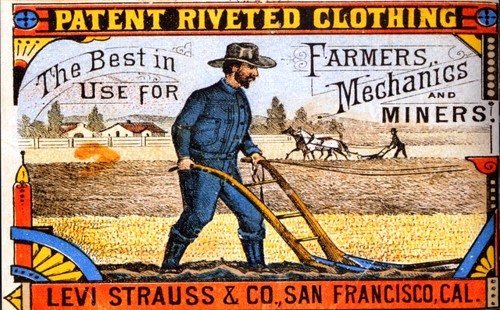The value of a brand is built upon how your audience perceives you. Leading brands thrive through promoting a lifestyle, experience, and an ideology that resonates with their potential customer base. Brands are constantly communicating their value, and successful brands reach ubiquity through a constant reforming of their image to reinvigorate their appeal.
Levi’s, for instance, is a brand that initially aimed to appeal to the rugged outdoorsman through their association with the cowboy when it was first established in 1853. Levi’s ads depicted wranglers and farm hands happily performing their duties while wearing the denim brand that’s internationally renowned today. This established Levi’s first mode of appeal; appealing to the worker, the labourer, and offering a product that would be ideal for their life or that of the mythic cowboy. This continues to be a recurring motif in modern Levi ads, demonstrating the authenticity of the brand.
Credit: Levi Strauss & Co.
Customers require trust, sincerity, and a story that they can relate to in order to connect with a brand identity. This is achieved by carefully crafted brand storytelling. Levi’s is successful because it inspires, motivates, and cultivates an ideology that customers seek out. They’ve carved out an influential brand ideology that motivates their target audience to participate in that experience. Appealing to diverse groups in society while hearkening back to their original success as the worker’s attire, Levi’s is relevant, trustworthy, and engaging for more people than ever before.
Crafting an Inclusive Brand Identity Over Time
Well into the mid-20th century, Levi’s continued to use the cowboy as their mythic symbol. To continue growth, Levi’s changed with the times to stay current, modern and, above all else, interesting. They understood the need to develop beyond this myth and broaden their brand identity with the changing times. As city life, metropolitanism, and the life of white collar office work developed, so too did Levi’s. The brand became a jean for everyone, a brand that felt at home in the office and the farmland simultaneously. What this shows is that brand identity is linked to brand psychology. Without losing sight of their brand roots, Levi’s appeals to modern consumers through the clever envisioning of these modern identities. These desirable identities are reflected in the multitude and breadth of advertisements Levi’s now produces, cementing their ubiquity with a catchall approach that first grew from the image of the cowboy.
Credit: Levi Strauss & Co.
The Secret to Marketing Success: Changing With Your Audience
If we briefly look to the Cycle of Consumerism, we can see how Levi’s has effectively used the cycle to maintain its trustworthy reputation. Traditional marketing, on the other hand, often only focused on creating a sales pitch and failed to engage meaningfully and evolve with its audience.
Cycle of Consumerism
- Awareness: The customer learns about Levi’s through storytelling branding. The brand incorporates a lifestyle that appeals to target customer’s needs and interests.
- Researching & Educating: Building trust to become a reliable and authentic resource.
- Considering & Comparing: Customers are shown why Levi’s jeans are superior through consideration and comparison.
- Final Decision & Transaction: The customer makes a final decision to purchase Levi’s brand jeans.
By building a foundation for the brand to express itself, storytelling incorporates images and identities that a prospective buyer may align with by using the product. Before the product is ever being sold, it is being marketed. Who wears a product and who the product is designed for often work harmoniously, as in the case of Levi’s with many different models designed for many different personalities and lifestyles – the 541 “Athletic” cut and the 510 “Skinny” taper represent these differences well. In the modern age, broad appeal beats out the niche, but what’s even better is the ability to maintain broad appeal while reaching niche audiences. Jeans became a product that is worn by both dominant and sub cultures – few clothing products are seen on both skateboarders and office workers alike, if any at all. In fact, jeans are an exception to the norm, transcending the boundaries traditionally rigid attire between work and leisure life, being both formal and informal at once.
Levi Strauss, the man behind the eponymous brand, likely had little foresight into how far denim would go. While it is a functional and capable product, it has moved from the stables to the city with relative ease. While holding onto the brand’s roots to establish authenticity and validity in the market, Levi’s has also broadened the scope of a once limited brand and product to become an inclusive staple in fashion and branding.



